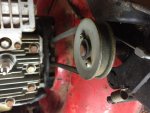Hey guys,
Last year I scored an older Troybilt Model number: 12AS5690063. The sellers got rid of it because the self propel isn't working. This thing runs like a champ, started on the first pull after winterization.
Since I like tinkering and learning about these old mowers, was going to attempt to fix the self propel. It does propel, but very slow. Front wheels engage when lifted. Will propel on concrete but not so much on grass. I figured it might be a worn belt. Removed the cover to reveal huge amounts of dirt. The belt looks pretty good to me but I'm not sure how tight its supposed to be. The drive bar does engage the cable at the transmission, although I'm not sure how far is fully engaged. I will continue to mess with it, perhaps look at tightening the cable.
Any thoughts about this?
Last year I scored an older Troybilt Model number: 12AS5690063. The sellers got rid of it because the self propel isn't working. This thing runs like a champ, started on the first pull after winterization.
Since I like tinkering and learning about these old mowers, was going to attempt to fix the self propel. It does propel, but very slow. Front wheels engage when lifted. Will propel on concrete but not so much on grass. I figured it might be a worn belt. Removed the cover to reveal huge amounts of dirt. The belt looks pretty good to me but I'm not sure how tight its supposed to be. The drive bar does engage the cable at the transmission, although I'm not sure how far is fully engaged. I will continue to mess with it, perhaps look at tightening the cable.
Any thoughts about this?

